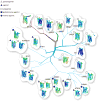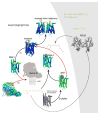Structural approaches to understanding retinal proteins needed for vision
- PMID: 24680428
- PMCID: PMC3971393
- DOI: 10.1016/j.ceb.2013.11.001
Structural approaches to understanding retinal proteins needed for vision
Abstract
The past decade has witnessed an impressive expansion of our knowledge of retinal photoreceptor signal transduction and the regulation of the visual cycle required for normal eyesight. Progress in human genetics and next generation sequencing technologies have revealed the complexity behind many inherited retinal diseases. Structural studies have markedly increased our understanding of the visual process. Moreover, technical innovations and improved methodologies in proteomics, macromolecular crystallization and high resolution imaging at different levels set the scene for even greater advances. Pharmacology combined with structural biology of membrane proteins holds great promise for developing innovative accessible therapies for millions robbed of their sight or progressing toward blindness.
Copyright © 2013 Elsevier Ltd. All rights reserved.
Figures




References
-
- Palczewski K. Chemistry and biology of vision. J Biol Chem. 2012;287:1612–1619. Visual perception in humans is initiated through absorption of photons by photoreceptors in the retina, a layered sensory organ containing all the necessary functional and structural proteins to support this process. How this remarkable tissue develops and operates over such an incredible dynamic range and how retinoids are recycled are some of the most fascinating questions in biology. With current methodology, it is now possible to identify all components of the retina and trace mutations to multiple blinding diseases. - PMC - PubMed
-
- Gilliam JC, Chang JT, Sandoval IM, Zhang Y, Li T, Pittler SJ, Chiu W, Wensel TG. Three-dimensional architecture of the rod sensory cilium and its disruption in retinal neurodegeneration. Cell. 2012;151:1029–1041. Using cryo-electron tomography, Wensel and colleagues obtained for the first time the 3D structure of the connecting cilium and adjacent cellular structures of a modified primary cilium in the rod outer segment isolated from wild type and disease model mice. This work revealed new structural features involved in cellular transport that is impaired by the involved genetic defects. - PMC - PubMed
-
- Palczewski K, Kumasaka T, Hori T, Behnke CA, Motoshima H, Fox BA, Le Trong I, Teller DC, Okada T, Stenkamp RE, Yamamoto M, Miyano M. Crystal structure of rhodopsin: A G protein-coupled receptor. Science. 2000;289:739–745. - PubMed
Publication types
MeSH terms
Substances
Grants and funding
LinkOut - more resources
Full Text Sources
Other Literature Sources
Miscellaneous

